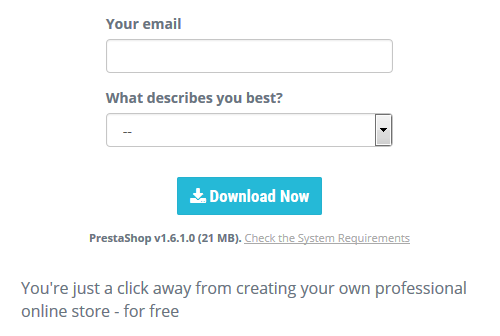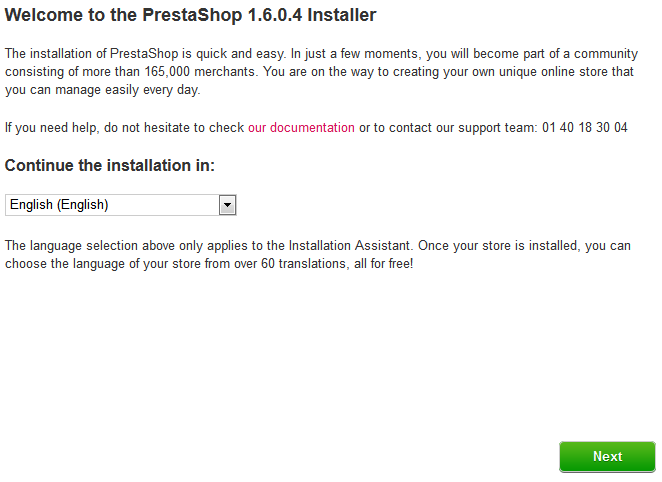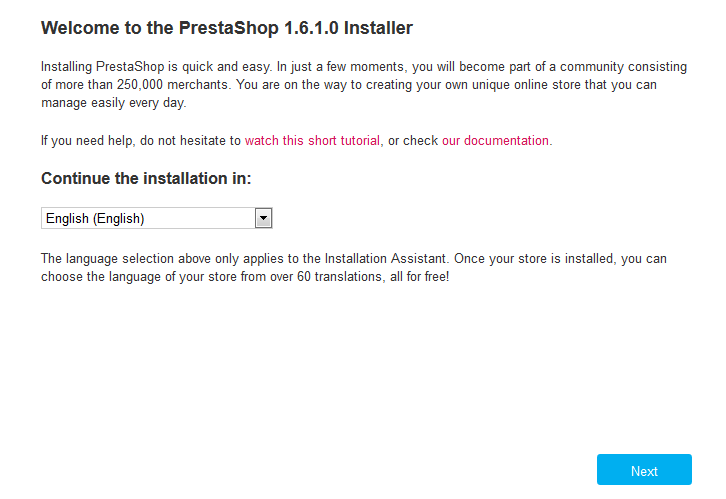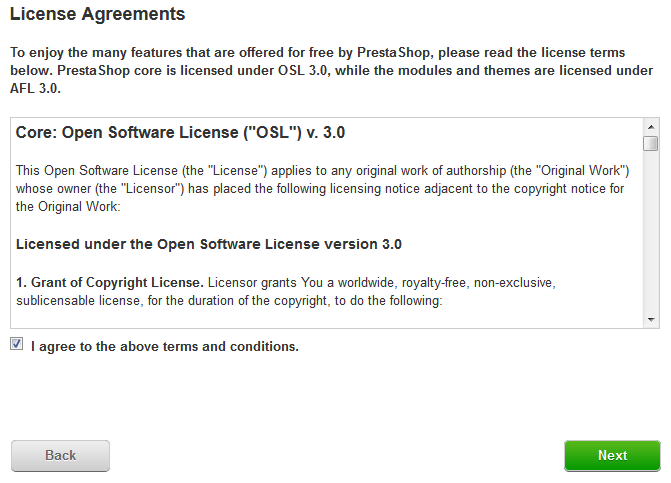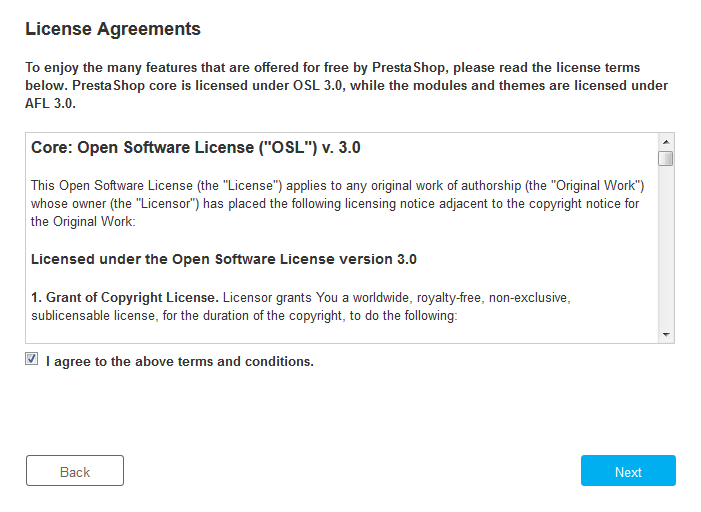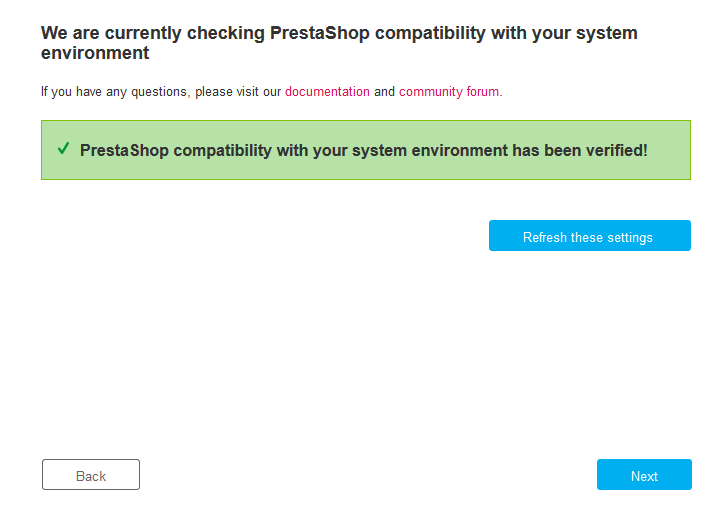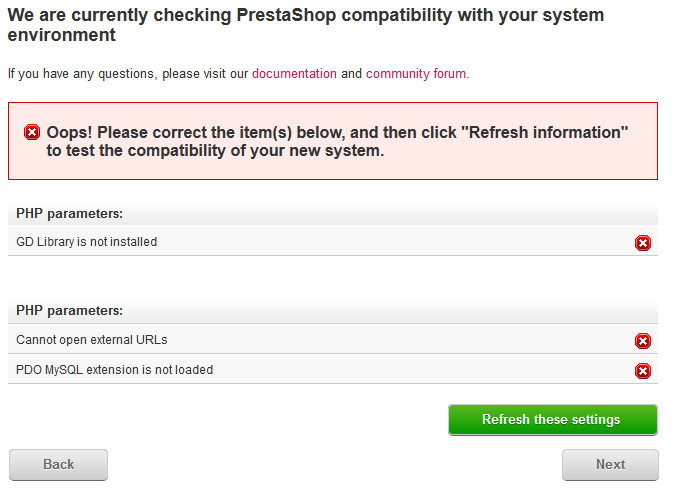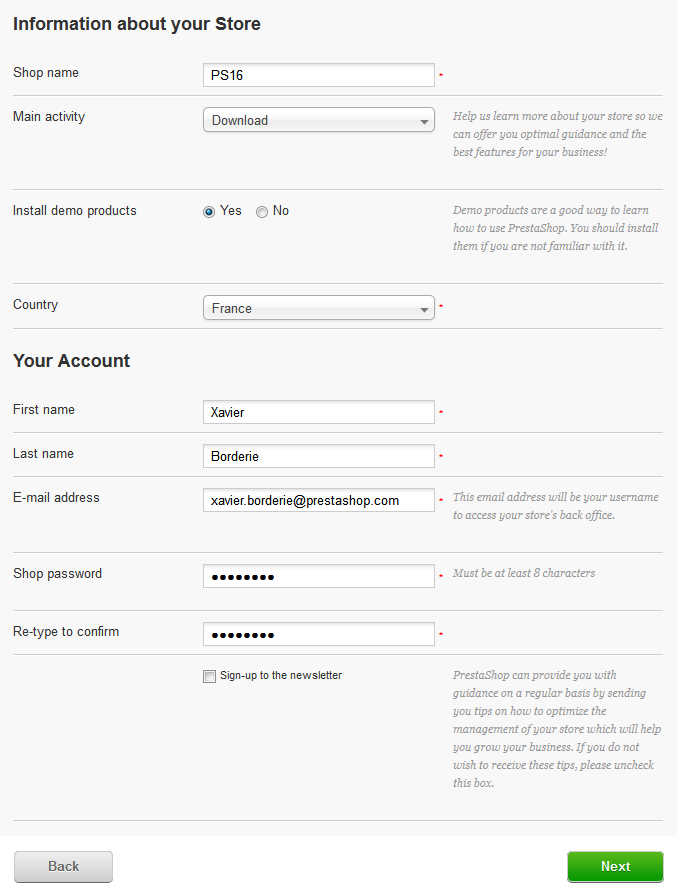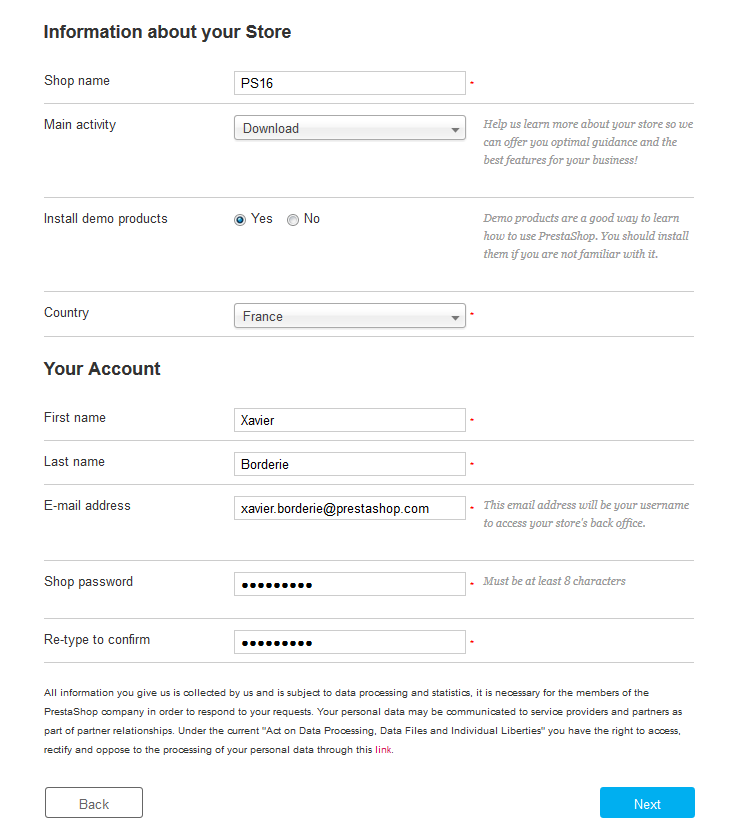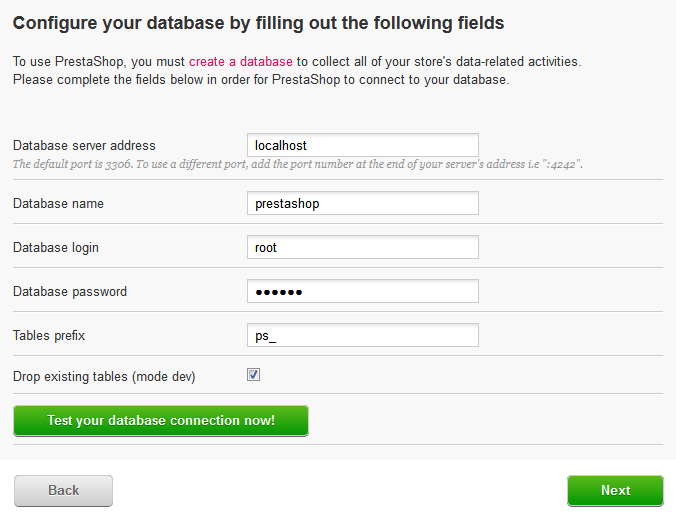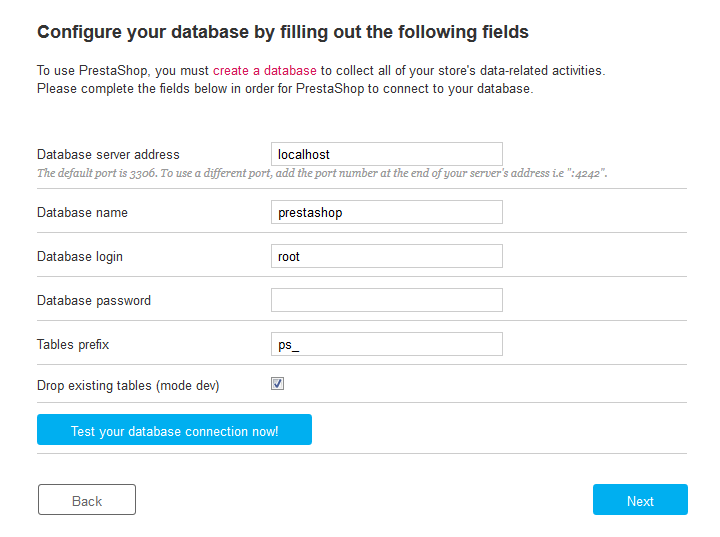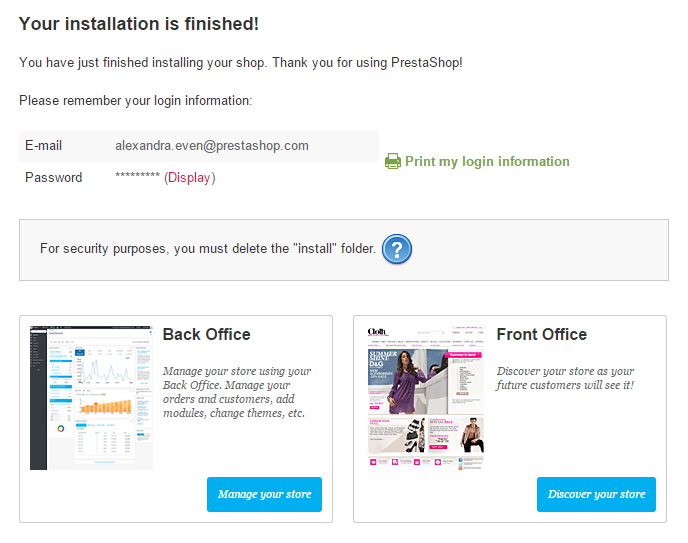...
| Note |
|---|
This chapter was written for those who intend on installing to install PrestaShop on their online web server. If you have already read the instructions on that page, skip to the "Creating a database for your shop" section of this current page. |
Installing PrestaShop in 10 minutes
PrestaShop is very easy to install. Once all the files are on your web server, you should be able to start configuring your shop in no less than 5 minutes in most cases: the installation process is very simple, as the installer takes care of everything for you. Less experienced users might need between 10 and 20 minutes to complete the whole process.
Before you get started, make sure you have all the requirements available: server space at a hosting provider, domain name, FTP client, text editor. Makes sure to follow the instructions in the "What you need to get started" page first: http://doc.prestashop.com/display/PS16/What+you+need+to+get+started.
| Tip |
|---|
Some web-hosts Our official web hosting partner 1&1 offer a 1-click install in order to save you time and get you started even faster. Using these can drastically reduce the installation time for inexperienced users.
Those web hosts mostly use the following script libraries:
Some of these scripts even support 1-click update, which is invaluable. Other hosts have their own installation scripts. Check with your own host for more information. Last but not least, PrestaShop has its own hosting solution: by registering on PrestaShop.com, you can create a 100% free PrestaShop Cloud store, and thus offload all the technical hurdles of hosting to our own team, and can focus on your shop, clients and sales. Visit https://www.prestashop.com/ for more information. |
Quick installation instructions
...
You can download the latest version of PrestaShop at http://www.prestashop.com/en/download.
You only have one download option: the latest stable version, ready for all kinds of online stores.
...
- Your host:
- Some hosts may require you to place your files in a specific folder, such as
/htdocs,/public_html,/web,/www,/yourdomainname.com, etc. - Other hosts' FTP server will simply log you directly into the proper upload space.
- Some hosts may require you to place your files in a specific folder, such as
- Your needs:
- If you want your shop to be the main website for your domain name (i.e., http://www.example.com), upload PrestaShop at the root folder of the upload space (which may depend on the host).
- If you want your shop to be in a sub-folder of your domain name (http://www.example.com/shop), you must first create said a folder through FileZilla (right-click and choose "Create directory"), then upload PrestaShop in that folder.
- If you want your shop to be in a sub-domain of your domain name (http://shop.example.com), you must first create said a sub-domain. This depends on your host: you might be able to do it simply by adding a new folder with your FTP client, or you might have to create the sub-domain through your host's administration panel. Read your host's support documentation first. Once created, browse to the sub-domain's folder, and upload PrestaShop there.
...
The installation process is quite easy, as it is streamlined by PrestaShop's auto-installer. You should be able to browse through it in handful of minutes. Do Make sure to read each page thoroughly so as not to not miss any information.
To launch the installer, simply browse to PrestaShop's location on your web server: the script will automatically detect that PrestaShop is not yet installed, and will take you to the auto-installer.
You can also directly type the address of the /install folder: http://www.example.com/prestashop_folder/install.
...
There are 6 steps. At the top of the page, the installation assistant gives you a visualization of where you are in the process: the gray faces circles turn into smiling faces green check marks after each step that is completed.
Step 1: Welcome page
This page is a quick intro into the installation process. You can choose the language in which the installer will display its instructions.
You also get a link to the documentation site (http://doc.prestashop.com/), and the PrestaShop support phone number. You can learn more about our support service by going to http://support.prestashop.com/en/.
...
- Open Software License 3.0 for PrestaShop itself, which you can also read at http://www.opensource.org/licenses/OSL-3.0.
- Academic Free License 3.0 for the modules and themes, which you can also read at http://opensource.org/licenses/AFL-3.0.
You must agree to both licenses in order to install PrestaShop.
...
This page checks that everything is OK with your server configuration: PHP settings, permissions on files and folders, third-party tools, etc.
If anything goes wrong, the installer stops you here, enabling you to see the few technical details that need fixing, be it changing the PHP configuration or updating the file permissions.
Here is a list of the checks that are performed during this third step:
...
While changing permissions in your FTP client, you should regularly check that you have made the correct changes by running the installer's compatibility checks again: click the installer's "Refresh these settings" button as often as necessary.
Once all indicators are green, you can click "Next". If you cannot have them all green, at least make sure the installer displays the "PrestaShop compatibility with your system environment has been verified!" message at the top of the page.
...
Store information
This is where you can start customizing your shop: give it a name and a logo, indicate its main activity, and indicate the personal information for the shop owner (which has legal binding in most countries)...
| Warning |
|---|
Do not use a colon in your store's name, as it might prevent some feature from working (for instance, e-mail sending might fail). You can replace the colon with a dash if you need to have two sections in the title. For instance, use "MyStore – The best place for items to buy" instead of "MyStore: The best place for items to buy". |
Concerning the logo, you should note that it will appear:
- On all of the pages of your store (depending on your theme).
- In your back office.
- In all of the e-mails sent to your customers.
- In all of your contractual documents (bills, return authorizations, etc.).
Therefore, do not keep the default PrestaShop logo, for obvious reasons.
This is also where you choose the password to log in to the administration panel of your shop - choose wisely so that you will remember it, but make sure it is secure too!
Click "Next" to continue.
...
This page contains a form that enables you to tell PrestaShop where the database server is, and which database it should use, along with a few other details. All this information should have been provided to you by your web host.
Fill all the fields with the database connection information provided by your web-host:
...
Click "Next": the install will start configuring your shop, creating and populating the database tables, etc. This might take a few minutes: please be patient and do not touch your browser!
The installer does the following:
...
As you can read right on the final page of the installation process, there are a couple of last actions to perform before you can leave the installer.
An easy way to improve your installation's security is to delete some key files and folders. This is done using your FTP client, directly on the server. The items to delete are:
...

